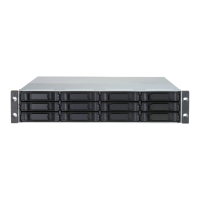VessRAID 1000i Series Product Manual
158
Managing Disk Arrays
Disk Array Management includes the following functions:
• Creating a Disk Array (page 158)
• Deleting a Disk Array (page 162)
• Viewing Disk Array Information (page 162)
• Setting an Alias for a Disk Array (page 163)
• Enabling Media Patrol on a Disk Array (page 164)
• Enabling PDM on a Disk Array (page 164)
• Preparing the Disk Array for Transport (page 164)
• Rebuilding a Disk Array (page 164)
• Migrating a Disk Array (page 165)
• Running PDM (page 166)
• Running Transition on a Disk Array (page 166)
• Locating a Disk Array (page 166)
• Locating a Disk Array (page 166)
• Creating a Logical Drive (page 167)
• Deleting a Logical Drive (page 168)
Creating a Disk Array
The CLU provides three methods of creating a disk array:
• Automatic – Creates a new disk array following a default set of parameters.
Makes one logical drive automatically. Also makes a hot spare drive for all
RAID levels except RAID 0, if at least five unconfigured physical drives are
available. If you have multiple enclosures, multiple disk array and logical
drive sets are created. See “Creating a Disk Array – Automatic” on
page 159.
• Express – You choose the parameters for a new disk array by specifying the
characteristics you want. You can create multiple logical drives at the same
time, however they will all be identical. You can choose to make a hot spare
drive for all RAID levels except RAID 0, if at least five unconfigured physical
drives are available. See “Creating a Disk Array – Express” on page 160.
• Advanced – You directly specify all parameters for a new disk array. Makes
one logical drive automatically. You can create additional logical drives at a
later time, if additional configurable capacity is available. Does not make a
hot spare drive. See “Creating a Disk Array – Advanced” on page 161.

